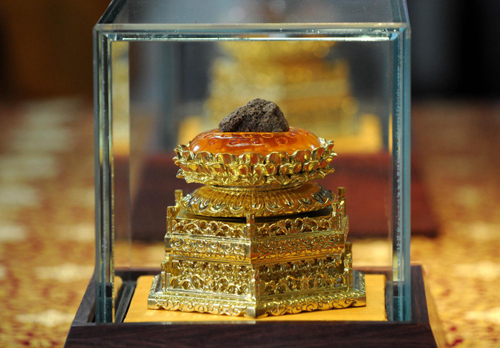Society
'Buddha remains' unveiled in E China temple
(Xinhua)
Updated: 2010-06-13 09:25
 |
Large Medium Small |
NANJING - Chinese Buddhist monks and archaeologists revealed what they believed to be top part of the skull of Sakyamuni, the founder of Buddhism, Saturday morning in east China's Jiangsu Province.
 |
The object, taken out for the first time around 9 am from a miniature gold coffin nestled inside a silver one, was part of Buddha's parietal bone, said Master Chuan Yin, president of the Buddhist Association of China, after attending the worshipping ceremony held in Qixia Temple in Nanjing, capital of Jiangsu Province.
The bone, irregular and light brown, looked like a small rock. "It is full of cell-like cavities, just like a honeycomb," said Hua Guorong, deputy head of Nanjing City Museum.
"Our findings conform with the descriptions of the parietal bone in historical records," said Master Xue Cheng, vice president of the association, adding the bone was hugely sacred for Buddhists.
Besides Sakyamuni's remains, ten sacred pieces of remains of other Buddhas were also found in another gold and silver mini-coffin.
All the relics had been enshrined at Qixia Temple by 108 eminent Buddhist monks from the Chinese mainland, Macao and Taiwan. The relics would be open to believers at the temple for one month, Hua said.
To ensure the safety of the invaluable treasures, Saturday's activities were conducted under heavy security, as well the indoor temperature was kept stable at 20 degrees Celsius and humidity between 55 to 60 percent, he said.
The parietal bone of Sakyamuni, allegedly recovered from the cremation ash of Sakyamuni, had been stored in a miniature pagoda named the Pagoda of King Asoka unearthed two years ago in an underground shrine built in 1011 under the former Changgan Temple of Nanjing.
The palace was found when archaeologists began excavating the ruins of the Grand Bao'en Temple of Nanjing built in the Ming Dynasty (1368-1644 AD).
In July 2008, archaeologists found a stele in the palace, the inscription on it said the palace preserved a "Seven-Treasure Pagoda of King Asoka" containing gold and silver coffins with Sakyamuni's parietal bone and relics of other Buddhas inside.
One month later, an iron case containing a pagoda was unearthed from the palace. In November 2008, archaeologists removed the pagoda from the case and found two mini-coffins.
It is said that 2,500 years ago, Sakyamuni's disciples recovered one parietal bone, four teeth, two collar bones and 84,000 particles of relics from the cremation ash of Sakyamuni, according to Lu Jianfu, a senior official with the association.
Asoka, an Indian emperor (273 BC - 232 BC), allegedly collected all the parts of Sakyamuni's remains, stored them in pagoda-like shrines, and sent them to different parts of the world.
The pagoda in Nanjing is believed to be one of tens of thousands of "pagodas of King Asoka" that contain Sakyamuni's remains.
The four-layer, 1.21-m-high and 0.42-m-wide pagoda is allegedly the largest of its kind unearthed in China.
According to Tang Dynasty (618-907) Buddhist records, China had 19 pagodas of King Asoka holding Sakyamuni's relics. To date, it is believed seven of the pagodas have been found in different parts of the country.